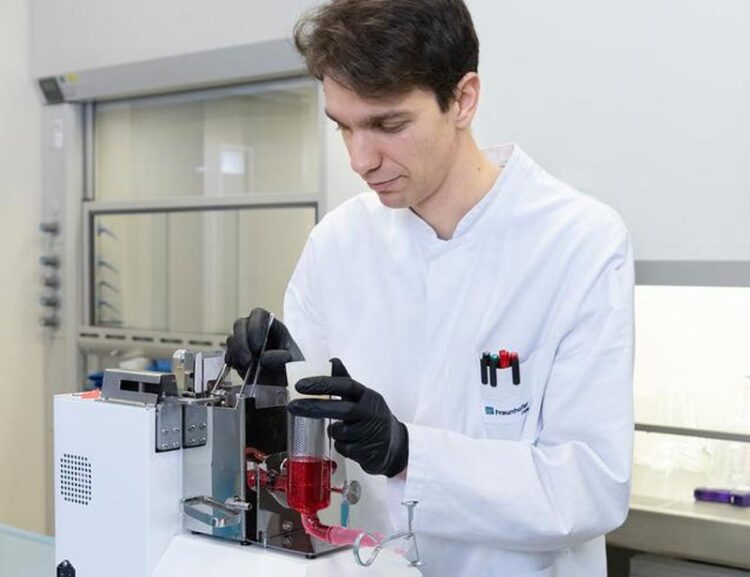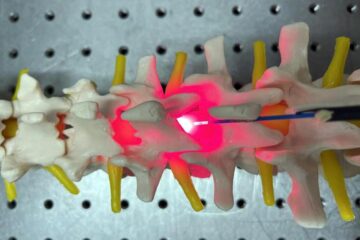The virus hackers

Scientist Dr. Philippe Vollmer Barbosa is initially testing whether the new RNAi active ingredients work at all in vitro using human lung tissue sections. This will be followed by further tests using in vitro lung test systems to determine the effect of inhalation.
© Fraunhofer ITEM/Ralf Mohr
RNAi therapy for viral respiratory diseases.
A research team from the Fraunhofer Institute for Toxicology and Experimental Medicine ITEM and the Hannover Medical School (MHH) have made significant progress in developing a new antiviral therapy. The drug, which is inhaled, uses RNAi to target and deactivate parainfluenza viruses before they multiply.
Parainfluenza viruses can trigger serious respiratory illnesses, especially in people with weakened immune systems and in children. There are currently few effective treatment options for patients except for bed rest and remedies to alleviate symptoms. RNA interference (RNAi) technology offers a new therapeutic approach. It works on the basis of a natural mechanism in our cells that regulates the activation of genes. In this case, specific sections of the virus’s genome are targeted and blocked, stopping it from synthesizing proteins. As a result, the patient’s immune system is better positioned to fight off viruses and stop them from spreading throughout the body. In the iGUARD (integrated Guided Ultrafast Antiviral RNAi Drug development) project, the researchers are using small snippets of RNA (known as siRNA — small interfering RNA) that act as a jigsaw piece, matching up and binding with specific sequences of the viral genome and immobilizing them.
In order to find out which specific sections of the viral genome need to be taken into account, the team is using molecular biological methods as well as computer-based drug design. Available genome databases are therefore used to prefilter relevant areas. “Our search is focused on any regions that the virus needs in order to replicate, as these are less likely to mutate,” explains Dr. Philippe Vollmer Barbosa, a project manager at Fraunhofer ITEM. “As such, we can significantly reduce resistance and immune escape caused by mutations.” By using this procedure, the conventional development process could be shortened from years or months to just a few weeks.
Inhalation as a silver bullet
The challenge here is to determine the best way for the drug to target the lungs. In order to transport the fragile siRNA right to where it is needed without losing a large amount of it and with few side effects, it needs to be inhaled. This process will use lipid nanoparticles — like those in the Covid-19 vaccines — as carriers. “However, when administered intravenously, lipid nanoparticles tend to concentrate in the liver, which is why siRNA drugs approved so far have been primarily aimed at liver diseases,” explains Prof. Armin Braun, one of the initiators of iGUARD and Division Director of Preclinical Pharmacology and Toxicology at Fraunhofer ITEM. He and his team are changing tack by using inhalation. “A big problem we were faced with was that the lipid nanoparticles available are often damaged or completely destroyed by the physical forces present during inhalation. They could also trigger a sometimes excessive immune response.” As a result, the researchers tested a lot of different lipid nanoparticle formulations until they found a formula that could better withstand vaporization during inhalation and still enter the cells safely. Since these have a relatively homogeneous distribution, fewer undesirable side effects were observed during inhalation.
Following computer-based simulations and various in-vitro tests using Fraunhofer ITEM’s specialized ultra-modern lung test systems, the drug was able to be tested on living organisms. In the first in-vivo tests, researchers were able to approximately halve the viral load in the lungs. Further tests are now being carried out to ascertain the optimum dose. The first clinical phase is expected to start in 2025 and Dr. Philippe Vollmer Barbosa is optimistic: “We are primarily interested in patients with lung transplants. This is because they are at particular risk of suffering from severe respiratory illnesses. What’s more, these patients already undergo monitoring as soon as they get a cold,” explains the biochemist. “This is important because — as with all antiviral medications — treatment with siRNA drugs needs to happen as early as possible.” After the second and third clinical phases, Vollmer Barbosa is confident that the first drugs could possibly be available on the market within the next five or six years.
Although the main focus of the iGUARD experts’ developments is parainfluenza viruses, the innovative process certainly has the potential to revolutionize — and accelerate — the development of other antiviral therapies. As a result, the platform technology could become an important building block in preparing for future pandemics. The combination of inhalable therapies and RNAi technology has also won over the German Federal Agency for Disruptive Innovation (Bundesagentur für Sprunginnovationen — SPRIND): In the innovation competition SPRIND challenge “Broad-Spectrum Antivirals,” the project reached the finals of the third and last rounds, receiving 2.5 million euros in funding.
Weitere Informationen:
https://www.fraunhofer.de/en/press/research-news/2024/february-2024/the-virus-ha…
Media Contact
All latest news from the category: Life Sciences and Chemistry
Articles and reports from the Life Sciences and chemistry area deal with applied and basic research into modern biology, chemistry and human medicine.
Valuable information can be found on a range of life sciences fields including bacteriology, biochemistry, bionics, bioinformatics, biophysics, biotechnology, genetics, geobotany, human biology, marine biology, microbiology, molecular biology, cellular biology, zoology, bioinorganic chemistry, microchemistry and environmental chemistry.
Newest articles

Red light therapy for repairing spinal cord injury passes milestone
Patients with spinal cord injury (SCI) could benefit from a future treatment to repair nerve connections using red and near-infrared light. The method, invented by scientists at the University of…

Insect research is revolutionized by technology
New technologies can revolutionise insect research and environmental monitoring. By using DNA, images, sounds and flight patterns analysed by AI, it’s possible to gain new insights into the world of…

X-ray satellite XMM-newton sees ‘space clover’ in a new light
Astronomers have discovered enormous circular radio features of unknown origin around some galaxies. Now, new observations of one dubbed the Cloverleaf suggest it was created by clashing groups of galaxies….





















